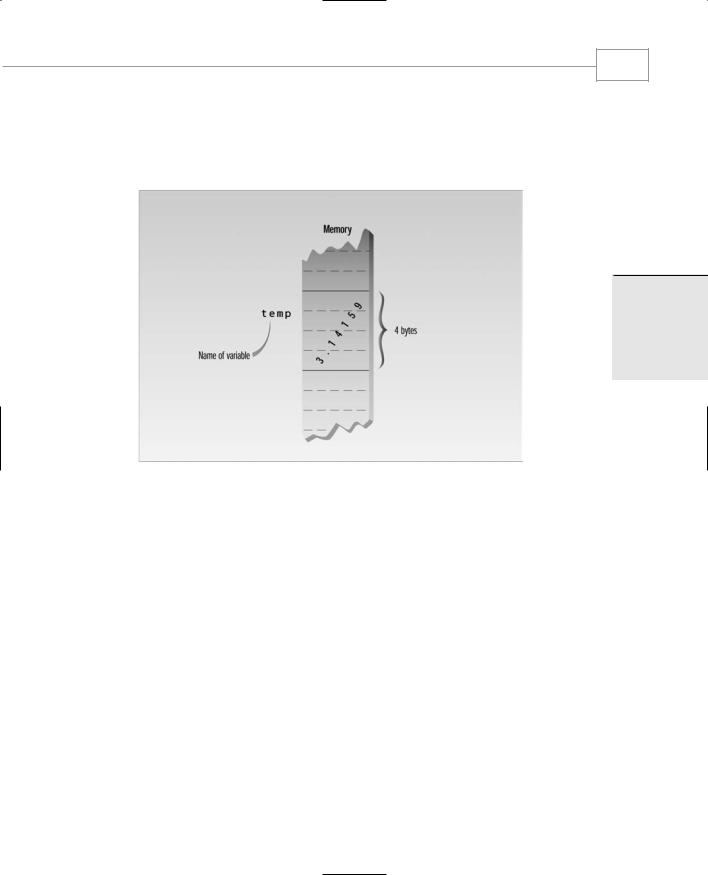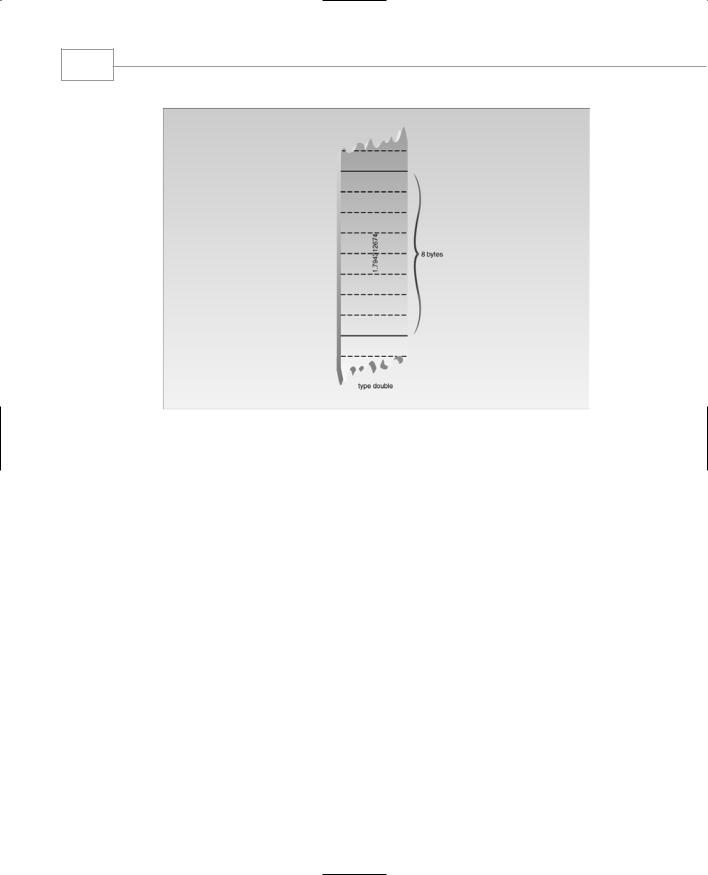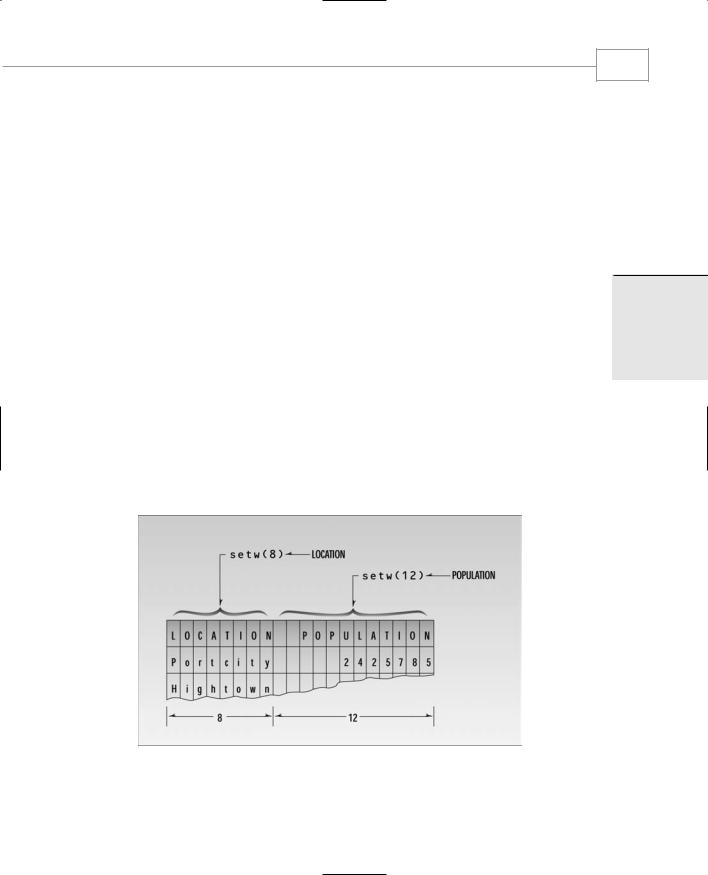
lafore_robert_objectoriented_programming_in_c
.pdf
C++ Programming Basics
TABLE 2.1 Continued
Escape Sequence |
Character |
\ n |
Newline |
\ r |
Return |
\ t |
Tab |
\ \ |
Backslash |
\ ‘ |
Single quotation mark |
\ “ |
Double quotation marks |
\ xdd |
Hexadecimal notation |
|
|
Since the backslash, the single quotation marks, and the double quotation marks all have specialized meanings when used in constants, they must be represented by escape sequences when we want to display them as characters. Here’s an example of a quoted phrase in a string constant:
cout << “\”Run, Spot, run,\” she said.”;
This translates to
“Run, Spot, run,” she said.
Sometimes you need to represent a character constant that doesn’t appear on the keyboard, such as the graphics characters above ASCII code 127. To do this, you can use the ‘\xdd’ representation, where each d stands for a hexadecimal digit. If you want to print a solid rectangle, for example, you’ll find such a character listed as decimal number 178, which is hexadecimal number B2 in the ASCII table. This character would be represented by the character constant ‘\xB2’. We’ll see some examples of this later.
The CHARVARS program prints the value of charvar1 (‘A’) and the value of charvar2 (a tab). It then sets charvar1 to a new value (‘B’), prints that, and finally prints the newline. The output looks like this:
AB
Input with cin
45
2
B PROGRAMMING C++
ASICS
Now that we’ve seen some variable types in use, let’s see how a program accomplishes input. The next example program asks the user for a temperature in degrees Fahrenheit, converts it to Celsius, and displays the result. It uses integer variables.

Chapter 2
46
//fahren.cpp
//demonstrates cin, newline #include <iostream>
using namespace std;
int main()
{
int ftemp; //for temperature in fahrenheit
cout << “Enter temperature in fahrenheit: “; cin >> ftemp;
int ctemp = (ftemp-32) * 5 / 9;
cout << “Equivalent in Celsius is: “ << ctemp << ‘\n’; return 0;
}
The statement
cin >> ftemp;
causes the program to wait for the user to type in a number. The resulting number is placed in the variable ftemp. The keyword cin (pronounced “C in”) is an object, predefined in C++ to correspond to the standard input stream. This stream represents data coming from the keyboard (unless it has been redirected). The >> is the extraction or get from operator. It takes the value from the stream object on its left and places it in the variable on its right.
Here’s some sample interaction with the program:
Enter temperature in fahrenheit: 212
Equivalent in Celsius is: 100
Figure 2.5 shows input using cin and the extraction operator >>.
FIGURE 2.5
Input with cin.

C++ Programming Basics
Variables Defined at Point of Use
The FAHREN program has several new wrinkles besides its input capability. Look closely at the listing. Where is the variable ctemp defined? Not at the beginning of the program, but in the next-to-the-last line, where it’s used to store the result of the arithmetic operation. As we noted earlier, you can define variables throughout a program, not just at the beginning. (Many languages, including C, require all variables to be defined before the first executable statement.)
Defining variables where they are used can make the listing easier to understand, since you don’t need to refer repeatedly to the start of the listing to find the variable definitions. However, the practice should be used with discretion. Variables that are used in many places in a function are better defined at the start of the function.
Cascading <<
The insertion operator << is used repeatedly in the second cout statement in FAHREN. This is perfectly legal. The program first sends the phrase Equivalent in Celsius is: to cout, then it sends the value of ctemp, and finally the newline character ‘\n’.
The extraction operator >> can be cascaded with cin in the same way, allowing the user to enter a series of values. However, this capability is not used so often, since it eliminates the opportunity to prompt the user between inputs.
Expressions
Any arrangement of variables, constants, and operators that specifies a computation is called an expression. Thus, alpha+12 and (alpha-37)*beta/2 are expressions. When the computations specified in the expression are performed, the result is usually a value. Thus if alpha is 7, the first expression shown has the value 19.
Parts of expressions may also be expressions. In the second example, alpha-37 and beta/2 are expressions. Even single variables and constants, like alpha and 37, are considered to be expressions.
Note that expressions aren’t the same as statements. Statements tell the compiler to do something and terminate with a semicolon, while expressions specify a computation. There can be several expressions in a statement.
Precedence
Note the parentheses in the expression
47
2
B PROGRAMMING C++
ASICS
(ftemp-32) * 5 / 9

Chapter 2
48
Without the parentheses, the multiplication would be carried out first, since * has higher priority than -. With the parentheses, the subtraction is done first, then the multiplication, since all operations inside parentheses are carried out first. What about the precedence of the * and / signs? When two arithmetic operators have the same precedence, the one on the left is executed first, so in this case the multiplication will be carried out next, then the division. Precedence and parentheses are normally applied this same way in algebra and in other computer languages, so their use probably seems quite natural. However, precedence is an important topic in C++. We’ll return to it later when we introduce different kinds of operators.
Floating Point Types
We’ve talked about type int and type char, both of which represent numbers as integers—that is, numbers without a fractional part. Now let’s examine a different way of storing numbers— as floating-point variables.
Floating-point variables represent numbers with a decimal place—like 3.1415927, 0.0000625, and –10.2. They have both an integer part, to the left of the decimal point, and a fractional part, to the right. Floating-point variables represent what mathematicians call real numbers, which are used for measurable quantities such as distance, area, and temperature. They typically have a fractional part.
There are three kinds of floating-point variables in C++: type float, type double, and type long double. Let’s start with the smallest of these, type float.
Type float
Type float stores numbers in the range of about 3.4x10–38 to 3.4x1038, with a precision of seven digits. It occupies 4 bytes (32 bits) in memory, as shown in Figure 2.6.
The following example program prompts the user to type in a floating-point number representing the radius of a circle. It then calculates and displays the circle’s area.
//circarea.cpp
//demonstrates floating point variables
#include <iostream> |
//for cout, etc. |
using namespace std; |
|
int main() |
|
{ |
|
float rad; |
//variable of type float |
const float PI = 3.14159F; |
//type const float |
cout << “Enter radius of circle: “; |
//prompt |
cin >> rad; |
//get radius |

C++ Programming Basics
49
float area = PI * rad |
* rad; |
//find area |
cout << “Area is “ << |
area << endl; |
//display answer |
return 0; |
|
|
} |
|
|
2
B PROGRAMMING C++
ASICS
FIGURE 2.6
Variable of type float in memory.
Here’s a sample interaction with the program:
Enter radius of circle: 0.5
Area is 0.785398
This is the area in square feet of a 12-inch LP record (which has a radius of 0.5 feet). At one time this was an important quantity for manufacturers of vinyl.
Type double and long double
The larger floating point types, double and long double, are similar to float except that they require more memory space and provide a wider range of values and more precision. Type double requires 8 bytes of storage and handles numbers in the range from 1.7x10–308 to 1.7x10308 with a precision of 15 digits. Type long double is compiler-dependent but is often the same as double. Type double is shown in Figure 2.7.

Chapter 2
50
FIGURE 2.7
Variable of type double.
Floating-Point Constants
The number 3.14159F in CIRCAREA is an example of a floating-point constant. The decimal point signals that it is a floating-point constant, and not an integer, and the F specifies that it’s type float, rather than double or long double. The number is written in normal decimal notation. You don’t need a suffix letter with constants of type double; it’s the default. With type long double, use the letter L.
You can also write floating-point constants using exponential notation. Exponential notation is a way of writing large numbers without having to write out a lot of zeros. For example, 1,000,000,000 can be written as 1.0E9 in exponential notation. Similarly, 1234.56 would be written 1.23456E3. (This is the same as 1.23456 times 103.) The number following the E is called the exponent. It indicates how many places the decimal point must be moved to change the number to ordinary decimal notation.
The exponent can be positive or negative. The exponential number 6.35239E–5 is equivalent to 0.0000635239 in decimal notation. This is the same as 6.35239 times 10–5.

C++ Programming Basics
51
The const Qualifier
Besides demonstrating variables of type float, the CIRCAREA example also introduces the qualifier const. It’s used in the statement
const float PI = 3.14159F; //type const float
The keyword const (for constant) precedes the data type of a variable. It specifies that the value of a variable will not change throughout the program. Any attempt to alter the value of a variable defined with this qualifier will elicit an error message from the compiler.
The qualifier const ensures that your program does not inadvertently alter a variable that you intended to be a constant, such as the value of PI in CIRCAREA. It also reminds anyone reading the listing that the variable is not intended to change. The const modifier can apply to other entities besides simple variables. We’ll learn more about this as we go along.
The #define Directive
Although the construction is not recommended in C++, constants can also be specified using the preprocessor directive #define. This directive sets up an equivalence between an identifier and a text phrase. For example, the line
#define PI 3.14159
appearing at the beginning of your program specifies that the identifier PI will be replaced by the text 3.14159 throughout the program. This construction has long been popular in C. However, you can’t specify the data type of the constant using #define, which can lead to program bugs; so even in C #define has been superseded by const used with normal variables. However, you may encounter this construction in older programs.
Type bool
For completeness we should mention type bool here, although it won’t be important until we discuss relational operators in the next chapter.
We’ve seen that variables of type int can have billions of possible values, and those of type char can have 256. Variables of type bool can have only two possible values: true and false. In theory a bool type requires only one bit (not byte) of storage, but in practice compilers often store them as bytes because a byte can be quickly accessed, while an individual bit must be extracted from a byte, which requires additional time.
As we’ll see, type bool is most commonly used to hold the results of comparisons. Is alpha less than beta? If so, a bool value is given the value true; if not, it’s given the value false.
2
B PROGRAMMING C++
ASICS

Chapter 2
52
Type bool gets its name from George Boole, a 19th century English mathematician who invented the concept of using logical operators with true-or-false values. Thus such true/false values are often called Boolean values.
The setw Manipulator
We’ve mentioned that manipulators are operators used with the insertion operator (<<) to mod- ify—or manipulate—the way data is displayed. We’ve already seen the endl manipulator; now we’ll look at another one: setw, which changes the field width of output.
You can think of each value displayed by cout as occupying a field: an imaginary box with a certain width. The default field is just wide enough to hold the value. That is, the integer 567 will occupy a field three characters wide, and the string “pajamas” will occupy a field seven characters wide. However, in certain situations this may not lead to optimal results. Here’s an example. The WIDTH1 program prints the names of three cities in one column, and their populations in another.
//width1.cpp
//demonstrates need for setw manipulator #include <iostream>
using namespace std;
int main()
{
long pop1=2425785, pop2=47, pop3=9761;
cout << “LOCATION “ << “POP.” << endl
<<“Portcity “ << pop1 << endl
<<“Hightown “ << pop2 << endl
<<“Lowville “ << pop3 << endl; return 0;
}
Here’s the output from this program:
LOCATION POP.
Portcity 2425785
Hightown 47
Lowville 9761
Unfortunately, this format makes it hard to compare the numbers; it would be better if they lined up to the right. Also, we had to insert spaces into the names of the cities to separate them from the numbers. This is an inconvenience.

C++ Programming Basics
Here’s a variation of this program, WIDTH2, that uses the setw manipulator to eliminate these problems by specifying field widths for the names and the numbers:
//width2.cpp
//demonstrates setw manipulator #include <iostream>
#include <iomanip> |
// for setw |
using namespace std; |
|
int main()
{
long pop1=2425785, pop2=47, pop3=9761;
cout << setw(8) << “LOCATION” << setw(12)
<<“POPULATION” << endl
<<setw(8) << “Portcity” << setw(12) << pop1 << endl
<<setw(8) << “Hightown” << setw(12) << pop2 << endl
<<setw(8) << “Lowville” << setw(12) << pop3 << endl; return 0;
}
The setw manipulator causes the number (or string) that follows it in the stream to be printed within a field n characters wide, where n is the argument to setw(n). The value is rightjustified within the field. Figure 2.8 shows how this looks. Type long is used for the population figures, which prevents a potential overflow problem on systems that use 2-byte integer types, in which the largest integer value is 32,767.
FIGURE 2.8
53
2
B PROGRAMMING C++
ASICS
Field widths and setw.

Chapter 2
54
Here’s the output of WIDTH2:
LOCATION POPULATION
Portcity 2425785
Hightown 47
Lowville 9761
Cascading the Insertion Operator
Note that there’s only one cout statement in WIDTH1 and WIDTH2, although it’s written on multiple lines. In doing this, we take advantage of the fact that the compiler ignores whitespace, and that the insertion operator can be cascaded. The effect is the same as using four separate statements, each beginning with cout.
Multiple Definitions
We initialized the variables pop1, pop2, and pop3 to specific values at the same time we defined them. This is similar to the way we initialized char variables in the CHARVARS example. Here, however, we’ve defined and initialized all three variables on one line, using the same long keyword and separating the variable names with commas. This saves space where a number of variables are all the same type.
The IOMANIP Header File
The declarations for the manipulators (except endl) are not in the usual IOSTREAM header file, but in a separate header file called IOMANIP. When you use these manipulators you must #include this header file in your program, as we do in the WIDTH2 example.
Variable Type Summary
Our program examples so far have used four data types—int, char, float, and long. In addition we’ve mentioned types bool, short, double, and long double. Let’s pause now to summarize these data types. Table 2.2 shows the keyword used to define the type, the numerical range the type can accommodate, the digits of precision (in the case of floatingpoint numbers), and the bytes of memory occupied in a 32-bit environment.
TABLE 2.2 Basic C++ Variable Types
|
Numerical Range |
|
Digits of |
Bytes of |
Keyword |
Low |
High |
Precision |
Memory |
|
|
|
|
|
bool |
false |
true |
n/a |
1 |
char |
–128 |
127 |
n/a |
1 |
short |
–32,768 |
32,767 |
n/a |
2 |
